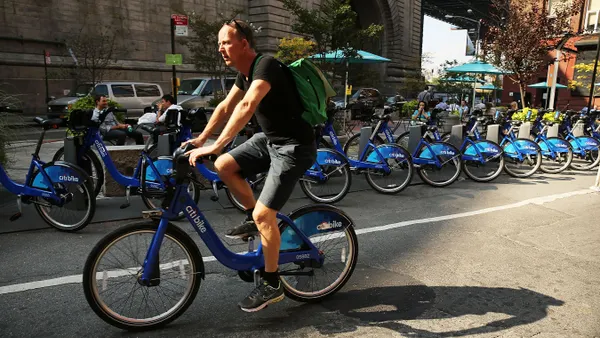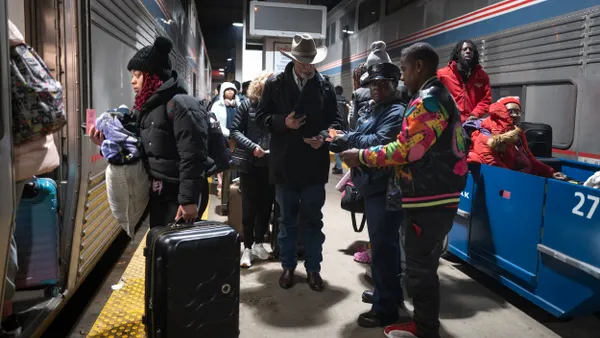LAS VEGAS — Automotive and mobility experts took the stage during a panel discussion dubbed "The Flying Car" at CES 2019 to discuss where the "flying car" industry is headed, who is leading the industry and what challenges must be faced before flying cars become a reality.
Of course, the flying car has been promised — and in development — for quite some time. When rolled out for public use, the electric vertical take-off and landing vehicles (VTOL) are said to drastically speed up travel times, reduce urban congestion and be comparable in price to a traditional ride-share option. Some companies like Bell Helicopter put these vehicles on display in the CES exhibit hall (to our excitement).
GUYS FLYING CARS ARE REALLY COMING AND LOOK HOW ENORMOUS THEY ARE pic.twitter.com/cS8AR2rKRi
— Kristin Musulin (@kristinmusulin) January 9, 2019
Despite tangible displays of the shiny hovercrafts, and plans to operate a network of these vehicles in major U.S. cities as early as next year, we may be further from a flying future than estimated. Throughout the discussion, Smart Cities Dive picked up on five main challenges that industry leaders will face to get flying cars off the ground — literally.
1. Leadership
"Somebody needs to blaze the trail for this," said Jeff Warra, senior automotive technology specialist with Spirent Communications. "This is not for the faint of heart." While startups are often brilliant companies, Warra doesn't believe they're suited to be leaders in the flying car space due to their inexperience compared to industry incumbents.
Warra and Stacey Randecker, co-host of The Flying Car radio show and a fellow panelist, both pointed to Uber Elevate as the most likely industry frontrunner. Randecker noted the company is bullish on its efforts to convene industry players and lock in target dates for service launches — the closest being the roll-out of flying taxi demos in Los Angeles and Dallas in 2020 .
"Having said that, this is their stated goal. Will they make it? I don't know," she said.
2. Public and city acceptance
Just as autonomous vehicles have faced distrust from consumers, flying cars will likely face the same hesitation — especially if even one mishap occurs during the demo or initial service phases.
Massimo Martinotti, head of mobility solutions at Italdesign, pointed to the impact that rare AV accidents and fatalities have had on the public — despite plenty of people dying in traditional vehicles every day. "The emotional impact is dramatic," he said. "We need to create a way to derive acceptance from the public."
"Cities and their attitudes" will also be one of the biggest hurdles to accepting vehicles in the airspace, said Randecker. Working with cities to regulate the vehicles will be a challenge just as it has been with e-scooters or AVs. However, similar to the explosion of e-scooters, cities need to open their eyes to the fact that these vehicles are coming fast, she said.
3. Safety — especially as it relates to weather
Unlike traditional commercial aircrafts that fly over the weather, flying cars will have a lower elevation, creating safety challenges when it comes to weather patterns.
The unpredictability of weather patterns will be an enormous challenge for companies and regulators hoping to bring commercial flying car services to market. "There's less room for error, you're not too far from the ground," Warra said, adding these are smaller aircrafts than traditional commercial flights, trying to work through volatile environments.
"We have to take baby steps, obviously," he said.
4. Partnerships
In order for vehicles to hit the market on the timeline that the industry hopes, Warra said partnerships will be crucial — among private companies and with the public sector.
Despite his comments on startups not being the right "leaders" for the flying car industry, Warra does think they are valuable partners to developers in the space. "The startup mentality is second to none, the creativity is amazing," he said. "They are hungry and that’s what we need in this industry. We need thought leaders and people to drive the tech, to go and approach this ... We can't fall in a rut of it being 'too difficult.'"
5. Autonomy
As is the current trend with consumer-facing vehicles, flying cars will need to be positioned for autonomy from the get-go, the panelists said.
"The pilot is weight that you're carrying around," said Randecker. In order for these vehicles to fly as quickly as they can, they will need to be as light as possible.
Of course, the vehicles will have pilots while in demo phases, but if and when they become an increasingly ubiquitous transportation option around the world, it will be "impossible to find 100,000 pilots just to move passengers" in the age of autonomy, said Martinotti.










